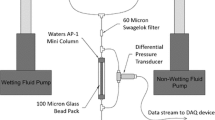Abstract
We use a new volume-of-fluid based finite-volume method to model two-phase flow through simple pore geometries and study the mechanisms controlling two-phase flow at the pore scale. The numerical model is used to study layer flow and snap-off, and investigate the effect of geometry and flow rate on trapping and mobilization of the disconnected ganglia. Furthermore, a new variable, the capillary field, is introduced to characterize the capillary force under dynamic situations, and a force-balance concept is presented to relate flow rates to pore-scale forces—dynamic pressure gradient and the capillary field. This description of the flow has the potential to be used in pore-network models to study the effect of pore-scale structures on the flow at larger scales. As an illustration of the applicability of this concept, we use the relations obtained from the numerical simulations to predict the threshold capillary number for blob mobilization during imbibition and show that this information can be used to reproduce the direct numerical simulation results accurately.














Similar content being viewed by others
Notes
Proof: The Laplacian operator (\({\nabla }^2\)) can be considered as the divergence of the gradient \(\nabla \cdot \varvec{\nabla }\), and the divergence (\(\nabla \cdot \)) is a linear operator. Therefore, from Eq. (6), we have: \(\nabla \,\cdot \, {\mathbf f}_\mathrm{c} - \nabla \,\cdot \, \varvec{\nabla } p_\mathrm{c} = 0\ \ \rightarrow \ \ \nabla \,\cdot \, ({\mathbf f}_\mathrm{c} - \varvec{\nabla } p_\mathrm{c})=0 \).
References
Al-Gharbi, M.S., Blunt, M.J.: Dynamic network modeling of two-phase drainage in porous media. Phys. Rev. E 71(1), 016308 (2005)
Berg, S., Ott, H., Klapp, S.A., Schwing, A., Neiteler, R., Brussee, N., Makurat, A., Leu, L., Enzmann, F., Schwarz, J.O., Kersten, M., Irvine, S., Stampanoni, M.: Real-time 3D imaging of Haines jumps in porous media flow. Proc. Natl. Acad. Sci. U.S.A. 110, 3755–3759 (2013)
Blunt, M.J., Bijeljic, B., Dong, H., Gharbi, O., Iglauer, S., Mostaghimi, P., Paluszny, A., Pentland, C.: Pore-scale imaging and modelling. Adv. Water Resour. 51, 197–216 (2013)
Brackbill, J.U., Kothe, D.B., Zemach, C.: A continuum method for modeling surface tension. J. Comput. Phys. 100(2), 335–354 (1992)
Bryant, S., Blunt, M.: Prediction of relative permeability in simple porous media. Phys. Rev. A 46(4), 2004–2011 (1992)
Dullien, F.A.L.: Porous Media: Fluid Transport and Pore Structure. Academic Press, San Diego (1979)
He, W., Yi, J.S., Van Nguyen, T.: Two-phase flow model of the cathode of PEM fuel cells using interdigitated flow fields. AIChE J. 46(10), 2053–2064 (2000)
Issa, R.I.: Solution of the implicitly discretized fluid flow equations by operator-splitting. J. Comput. Phys. 62(1), 40–65 (1986)
Kanner, B., Glass, J.E.: Surface viscosity and elasticity—significant parameters in industrial processes. Ind. Eng. Chem. 61(5), 31–41 (1969)
Lake, L.W.: Enhanced Oil Recovery. Prentice Hall, Englewood Cliffs (1989)
Lenormand, R., Zarcone, C., Sarr, A.: Mechanisms of the displacement of one fluid by another in a network of capillary ducts. J. Fluid Mech. 135, 337–353 (1983)
Mayer, R.P., Stowe, R.A.: Mercury porosimetry-breakthrough pressure for penetration between packed spheres. J. Colloid Sci. 20(8), 893–911 (1965)
Meakin, P., Tartakovsky, A.M.: Modeling and simulation of pore-scale multiphase fluid flow and reactive transport in fractured and porous media. Rev. Geophys. 47, RG3002 (2009)
Mogensen, K., Stenby, E.H.: A dynamic two-phase pore-scale model of imbibition. Transp. Porous Med. 32(3), 299–327 (1998)
OpenFOAM. The open source CFD toolbox. http://www.openfoam.org (2010). Accessed 25 June 2010
Oren, P.E., Bakke, S., Arntzen, O.J.: Extending predictive capabilities to network models. SPE J. 3(4), 324–336 (1998)
Payatakes, A.C.: Dynamics of oil ganglia during immiscible displacement in water-wet porous media. Annu. Rev. Fluid Mech. 14(1), 365–393 (1982)
Princen, H.M.: Capillary phenomena in assemblies of parallel cylinders: I. Capillary rise between two cylinders. J. Colloid Interface Sci. 30(1), 69–75 (1969)
Prodanović, M., Bryant, S.L.: A level set method for determining critical curvatures for drainage and imbibition. J. Colloid Interface Sci. 304(2), 442–458 (2006)
Raeini, A.Q., Blunt, M.J., Bijeljic, B.: Modelling two-phase flow in porous media at the pore scale using the volume-of-fluid method. J. Comput. Phys. 231(17), 5653–5668 (2012)
Ransohoff, T.C., Radke, C.J.: Laminar flow of a wetting liquid along the corners of a predominantly gas-occupied noncircular pore. J. Colloid Interface Sci. 121(2), 392–401 (1988)
Roof, J.G.: Snap-off of oil droplets in water-wet pores. SPE J. 10(1), 85–90 (1970)
Rubin, E., Meyer, L., de Coninck, H.: IPCC special report on carbon dioxide capture and storage. Prepared by working group III of the intergovernmental panel on climate change Intergovernmental Panel on Climate Change. Cambridge, UK (2005)
Rusche, H.: Computational fluid dynamics of dispersed two-phase flows at high phase fractions. PhD thesis, Imperial College London (2002)
Ryazanov, A.V., van Dijke, M.I.J., Sorbie, K.S.: Two-phase pore-network modelling: existence of oil layers during water invasion. Transp. Porous Med. 80(1), 79–99 (2009)
Stegmeier, G.L.: Mechanisms of entrapment and mobilization of oil in porous media. In: Shah, D.O., Schechter, R.S. (eds.) Improved Oil Recovery by Surfactant and Polymer Flooding. Academic Press, New York (1977)
Ubbink, O.: Numerical prediction of two fluid systems with sharp interfaces. PhD thesis, Imperial College London (1997)
Unsal, E., Mason, G., Ruth, D.W., Morrow, N.R.: Co- and counter-current spontaneous imbibition into groups of capillary tubes with lateral connections permitting cross-flow. J. Colloid Interface Sci. 315(1), 200–209 (2007)
Valvatne, P.H., Blunt, M.J.: Predictive pore-scale modeling of two-phase flow in mixed wet media. Water Resour. Res. 40(7), W07406 (2004)
Wang, Z.H., Wang, C.Y., Chen, K.S.: Two-phase flow and transport in the air cathode of proton exchange membrane fuel cells. J. Power Sources 94(1), 40–50 (2001)
Williams, M.W., Kothe, D.B., Puckett, E.G.: Accuracy and convergence of continuum surface tension models. In: Proceedings of Fluid Dynamics at Interfaces, pp. 294–305. Cambridge University Press, Cambridge (1998)
Yamasaki, A.: An overview of CO\(_2\) mitigation options for global warming-emphasizing CO\(_2\) sequestration options. J. Chem. Eng. Japan 36(4), 361–375 (2003)
Author information
Authors and Affiliations
Corresponding author
Rights and permissions
About this article
Cite this article
Raeini, A.Q., Bijeljic, B. & Blunt, M.J. Numerical Modelling of Sub-pore Scale Events in Two-Phase Flow Through Porous Media. Transp Porous Med 101, 191–213 (2014). https://doi.org/10.1007/s11242-013-0239-6
Received:
Accepted:
Published:
Issue Date:
DOI: https://doi.org/10.1007/s11242-013-0239-6




